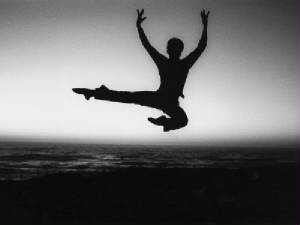|

|
| Silouette of Male Ballet Dancer by Bonnie Kamin |
In today's multi-media world it’s hard to keep track of which came first: the chicken
or the movie? It used to be that successful musical theater was adapted for the
big screen. Of course it’s risky business trying to take the intimacy and abstraction of the theater and translate it
to the less personal but bigger and more reality-based cinema. Some productions
made the leap successfully by not copying but capturing the essence of the play. In fact some projects have gone from
stage to film and back - think West Side Story or Guys and Dolls for example.
In
keeping with a new paradigm pioneered by Disney, Billy Elliot at the Imperial Theater goes in the other direction, attempting
to create musical theater from the movie of the same name. If you have yet to
see Billy Elliot, The Movie (go on line and add it to your NetFlix list right now) it is the story of a young boy in a working
class town in northern England during the infamous coal miners’ strike of 1984 – 1985. The principal theme however is Billy’s determination, drive and deep seated need to express himself through the world of classical ballet in spite of the overwhelming odds growing up in
a socially conservative household.
While there is no magic formula for successful musical
theater, surely there are several critical ingredients, the most obvious being the score.
|
 |
|
|
|
 |
In
this case, the producers commissioned Elton John, the talented pop singer/songwriter and composer. With the possible exception
of the opening number that sets the stage for the battle between miners and Margaret Thatcher's conservative, union busting
administration, unlike his work in The Lion King, the music is bland and forgettable.
Creating
a Broadway show about an aspiring dancer is kind of like casting Fred Astaire and Bing Crosby in Holiday Inn - on one hand
it’s a no-brainer but in another sense the expectation bar is automatically raised a notch or two. Happily, Peter Darling’s choreography and its execution are both exciting and memorable. Because the part of young (pre-teen) Billy who is on stage for almost the entire show is so demanding especially
for a child actor, there are three (four including the understudy) actors who rotate the part. We saw David Alvarez, who like
his character was surely born to dance. Early in the show Billy visits a girl’s dance studio and struggles to follow
the steps – this was probably the most challenging part of the role for the talented Alvarez. Later, the young Billy dances with his future self (Stephen Hanna) in a brilliantly conceived dance that
soars. The tension between the miners and Thatcher’s goons was creatively
captured in several numbers for the adult company. Kudos to casting director
Nora Brennan for selecting a group of talented but not typically cutesy young girls for the dance school pieces.
continued on next page
|
 |
|
|
|

